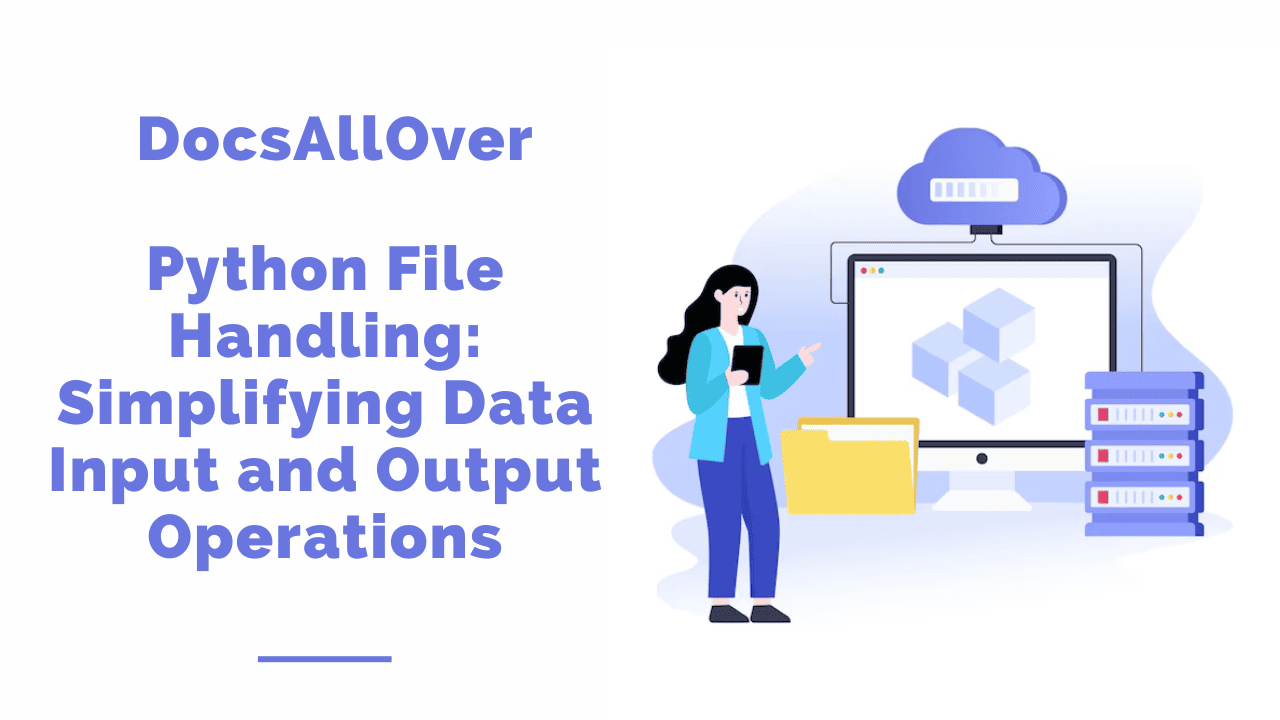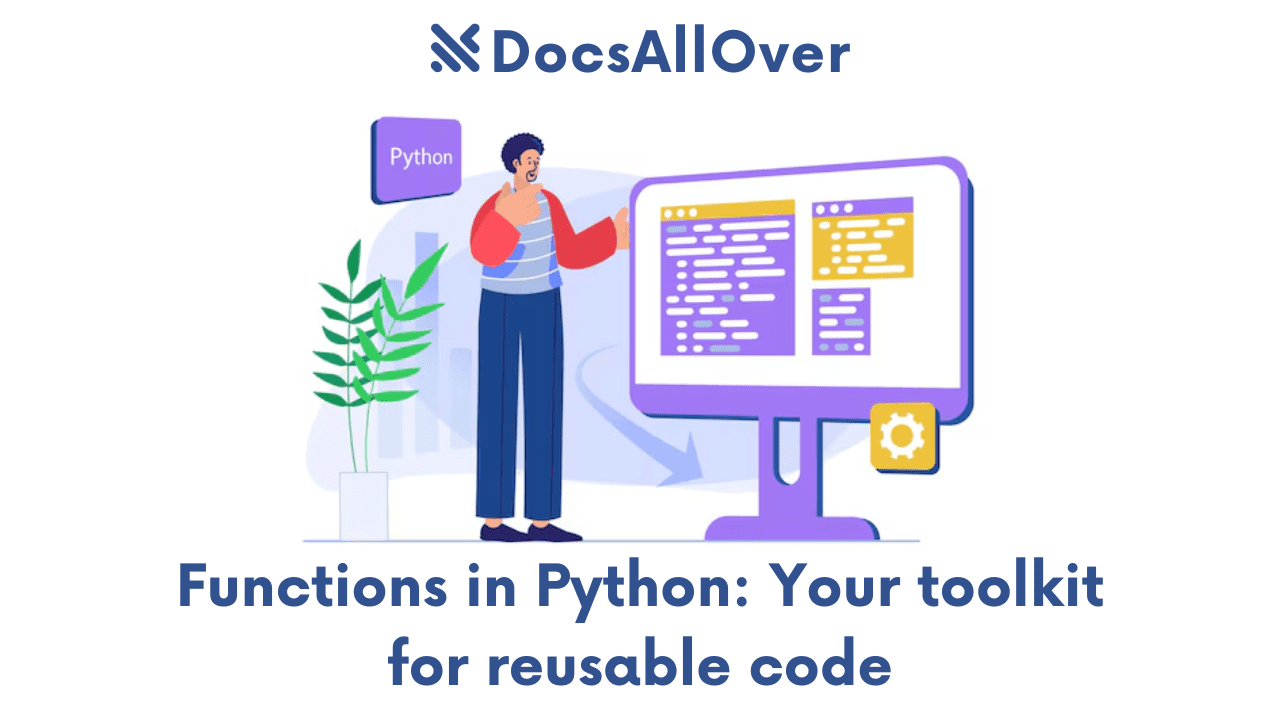Python File Handling: Simplifying Data Input and Output Operations

Python provides powerful file handling capabilities that allow you to efficiently read and write data to files. Whether you're working with text files, CSV files, or binary files, Python offers a variety of functions and methods to handle file operations with ease. In this blog, we'll explore the basics of file handling in Python, along with some practical examples and coding samples.
Python's file handling capabilities make it easy to read, write, and manipulate files efficiently and effectively. Python file handling can be used to simplify data input and output operations, organize data efficiently, and implement data security measures.
What is Python File Handling?
File handling in Python is the process of reading and writing data to and from files. Files are used to store data permanently, so that it can be accessed and used later, even after the program that created the file has finished running.
There are two main types of files in Python: text files and binary files. Text files are files that contain human-readable characters, such as letters, numbers, and symbols. Binary files are files that contain data in a format that cannot be read by humans, such as images, videos, and executable programs.
Python provides a number of built-in functions and classes for handling files. The most important function for file handling is the open() function. The open() function takes the name of the file to open and a mode string as arguments. The mode string specifies how the file will be opened. The most common mode strings are:
r- Open the file for reading.w- Open the file for writing. If the file does not exist, it will be created. If the file already exists, it will be overwritten.a- Open the file for appending. If the file does not exist, it will be created. If the file already exists, new data will be appended to the end of the file.
how Python file handling can be used in real-world applications:
- Reading and writing data to a database: Python file handling can be used to read and write data to a database, such as a MySQL or PostgreSQL database.
- Creating and managing log files: Python file handling can be used to create and manage log files, which can be used to track events and errors in an application.
- Processing large files: Python file handling can be used to process large files, such as CSV or XML files, efficiently.
- Creating and sharing documents: Python file handling can be used to create and share documents, such as PDF or Word documents.
Advanced File Handling Techniques
In addition to basic file handling operations, Python also supports a variety of advanced file handling techniques, such as:
- Binary file handling: Binary file handling is used to read and write binary data to files.
- File locking: File locking is used to prevent multiple processes from accessing the same file simultaneously.
- File buffering: File buffering is used to improve the performance of file operations by caching data in memory.
Benefits of using Python file handling
There are many benefits to using Python file handling, including:
- Simplifies data input and output: Python file handling provides a simple and easy-to-use way to read and write data to files. This can simplify a variety of data input and output operations, such as storing and retrieving data, creating and editing files, and transferring data between different applications.
- Improves performance: Python file handling can improve the performance of your Python applications by reducing the number of network requests that need to be made. For example, if you need to retrieve a large amount of data from a database, you can store the data in a file and then read the data from the file in your Python application. This can reduce the number of database queries that need to be made and improve the overall performance of your application.
- Increases flexibility: Python file handling increases the flexibility of your Python applications by allowing you to read and write data to a variety of different file formats. This can be useful for integrating your Python applications with other applications and systems.
Applications of Python file handling
Python file handling can be used in a variety of applications, including:
- Data storage and retrieval: Python file handling can be used to store and retrieve data from files. This can be useful for a variety of tasks, such as storing user data, storing application data, and storing log files.
- File creation and editing: Python file handling can be used to create and edit files. This can be useful for a variety of tasks, such as creating configuration files, creating reports, and creating log files.
- Data transfer: Python file handling can be used to transfer data between different applications and systems. This can be useful for a variety of tasks, such as importing and exporting data, and backing up data.
Basic File Handling Operations in Python
1. Opening and Closing Files:
- To open a file, you can use the `open()` function, specifying the file path and mode (e.g., read, write, append) as parameters.
- Once you're done with a file, it's important to close it using the
'close()'method to release system resources.
2. Reading Data from Files:
- The
'read()'method allows you to read the entire contents of a file as a string. - The
'readline()'method reads a single line from the file. - The
'readlines()'method returns a list of lines, where each line is a string.
3. Writing Data to Files:
- The
'write()'method writes a string to the file. - The
'writelines()'method writes a list of strings to the file.
4. Appending Data to Files:
- To append data to an existing file, open it in append mode (`"a"`) and use the
'write()'or'writelines()'method.
5. Closing Files Automatically with Context Managers:
- Python provides the
'with'statement that automatically takes care of closing the file after its block of code executes. This ensures proper resource management.
6. Working with CSV Files:
- The
'csv'module in Python allows easy reading and writing of CSV files using the'csv.reader'and'csv.writer'objects, respectively. - You can specify delimiters, dialects, and handle special cases like quoted fields using the various options provided by the `csv` module.
7. Binary File Handling:
- Python supports reading and writing binary data to files using the appropriate file modes (e.g., "rb" for reading binary, "wb" for writing binary).
- You can use methods like
'read()'and'write()'to handle binary data.
8. Error Handling:
- When working with files, it's crucial to handle potential errors. Python's
'try-except'blocks allow you to catch and handle exceptions that may occur during file operations.
9. Seek and Tell:
- The
'seek()'method allows you to change the current position within the file, enabling random access to different parts of the file. - The
'tell()'method returns the current position within the file, providing information about the file's read or write cursor location.
10. Working with File Paths:
- Python's
'os'module provides functions to handle file paths, such as'os.path.join()'for joining directory paths and filenames. - You can use
'os.path.exists()'to check if a file or directory exists, and'os.path.isfile()'and'os.path.isdir()'to determine if a given path corresponds to a file or directory.
11. File Handling Modes:
Python supports various file handling modes, including:
- Read mode ("r"): Allows reading from an existing file (default mode).
- Write mode ("w"): Creates a new file for writing or overwrites an existing file.
- Append mode ("a"): Opens a file for appending data at the end.
- Binary mode ("b"): Handles binary data (e.g., images, audio files).
- Text mode ("t"): Handles text data (default mode).
- Read and write mode ("r+" or "w+"): Allows both reading and writing to a file.
12. File Object Attributes and Methods:
- File objects in Python have several useful attributes and methods, including
'name','mode','closed','flush()','truncate()', and more. - These attributes and methods provide additional control and functionality when working with files.
13. Working with Directories:
Python's 'os' module offers functions to handle directory operations, such as creating directories (os.mkdir()), removing directories (os.rmdir()), and listing directory contents (os.listdir()).
Here are some additional details about each Python file handling example:
1. Reading from a File:
In this example, you can use the 'open()' function with the "r" mode to open an existing file for reading.
Once the file is opened, you can use the 'read()' method to retrieve the contents of the file as a string.
This example is useful when you need to extract data from a file for further processing or analysis.
2. Writing to a File:
With the "w" mode, you can open a file for writing or create a new file if it doesn't exist.
After opening the file, you can use the 'write()' method to write data to the file.
This example is handy when you want to store or save data to a file, such as output from your program or log files.
3. Appending to a File:
Using the "a" mode, you can open a file for appending data at the end.
The 'write()' method can be used to add new content to the existing file without overwriting its contents.
This example is beneficial when you want to continuously add data to a file, such as logging events or appending records to a log file.
4. Reading and Writing to a File:
The "r+" mode allows you to open a file for both reading and writing.
You can use the 'read()' method to retrieve data from the file and the 'write()' method to overwrite or add new content.
This example is useful when you need to read data from a file, make modifications, and write the updated data back to the same file.
5. Reading Line by Line:
By opening a file in read mode ("r"), you can use the 'readline()' method to read the file line by line.
Each call to 'readline()' retrieves the next line from the file, allowing you to process the file's contents line by line.
This example is handy when you're working with files that contain structured data, such as CSV or log files.
6. Using the 'with' Statement:
Python's 'with' statement ensures that the file is automatically closed after the code block is executed, even if an exception occurs.
By using 'with open(...) as file:', you eliminate the need to explicitly close the file, improving code readability and reducing the chance of resource leaks.
This example demonstrates best practices for handling files and is recommended when working with files in Python.
These examples showcase different aspects of Python file handling, such as reading, writing, appending, and working with files line by line. They illustrate common scenarios you may encounter when dealing with files in your Python programs, allowing you to manipulate and process data efficiently.
By understanding these examples, you can leverage Python's file handling capabilities to handle various file-related tasks effectively and streamline your data input and output operations.
Python's file handling capabilities make it a versatile language for working with various types of files. Whether you need to read data, write to files, or handle complex file formats, Python offers intuitive and flexible file handling options. By understanding the basics and leveraging the available methods and modules,you can efficiently handle file operations in your Python applications.










